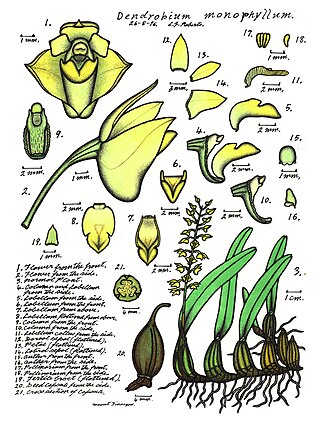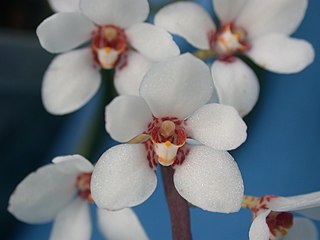
Dendrobium gracilicaule, commonly known as the blotched cane orchid or yellow cane orchid, is an epiphytic or lithophytic orchid in the family Orchidaceae. It has cylindrical pseudobulbs, between three and seven thin leaves and up to thirty often drooping, cream-coloured to yellow or greenish flowers, sometimes with reddish brown blotches on the back. There are two varieties, one occurring in Queensland and New South Wales and the other on some Pacific Islands, including Lord Howe Island.

Bulbophyllum baileyi, commonly known as the fruit fly orchid, is a species of epiphytic or lithophytic orchid that is native to Queensland and New Guinea. It has coarse, creeping rhizomes, curved, yellowish pseudobulbs with a single thick, fleshy leaf, and a single cream-coloured flower with yellow, red or purple spots. It grows on trees and rocks in open forest, often in exposed places.

Bulbophyllum elisae, commonly known as the pineapple orchid, is a species of epiphytic or lithophytic orchid that is endemic to eastern Australia. It has crowded, wrinkled, pale green or yellowish clump-forming pseudobulbs, stiff, pale green to yellowish leaves and between three and twelve pale green to dark green flowers with a dark red to purple labellum. It usually grows in the tops of rainforest trees, on cliff faces or boulders.

Peristeranthus hillii, commonly known as the beetle orchid or brown fairy-chain orchid is the only species in the genus Peristeranthus from the orchid family, Orchidaceae. It is an epiphytic or lithophytic orchid with more or less pendulous stems, between three and ten widely spaced, leathery leaves and a large number of pale green, often spotted flowers. It mainly grows on tree trunks and thick vines in rainforest and is found between the Bloomfield River in Queensland and Port Macquarie in New South Wales.

Dendrobium moorei, commonly known as the drooping cane orchid, is a species of epiphytic or lithophytic orchid in the family Orchidaceae and is endemic to Lord Howe Island. It has cylindrical pseudobulbs, leathery, dark green leaves and between two and fifteen small, white drooping flowers that do not open widely.

Phaius tankervilleaevar.australis, also known as the common swamp orchid, southern swamp-orchid, swamp lily or island swamp-orchid, is a species of orchid endemic to eastern Australia. It is an evergreen, terrestrial herb with large, crowded pseudobulbs, large pleated leaves and flowers that are reddish brown on the inside and white outside.

Dendrobium agrostophyllum, the buttercup orchid, is an epiphytic or lithophytic orchid in the family Orchidaceae and has a creeping rhizome with well-spaced pseudobulbs. Each pseudobulb has up to twenty grass-like leaves, some of the leaves having flowering stems on the opposite side of the pseudobulb, each raceme with up to ten waxy, fragrant, bright yellow flowers. It grows in wet forest in coast areas of north Queensland, Australia.

Dendrobium baileyi, commonly known as the blotched gemini orchid, is an epiphytic or lithophytic orchid in the family Orchidaceae and has arching stems and flowering stems with one or two spidery, yellow flowers with dark purple spots emerging from leaf axis. It grows in tropical North Queensland, New Guinea and the Solomon Islands.
Dendrobium fellowsii, commonly known as the native damsel orchid, is an epiphytic or lithophytic orchid in the family Orchidaceae and has upright pseudobulbs, up to five leaves and groups of up to five pale green or yellowish flowers with a deep purple labellum. It grows in tropical North Queensland.

Dendrobium monophyllum, commonly known as the lily-of-the-valley orchid, is an epiphytic or lithophytic orchid in the family Orchidaceae. It has pale green to yellowish pseudobulbs with one or two leaves, and between five and twenty bell-shaped yellow flowers. It grows in rainforest in New South Wales and Queensland, Australia.

Dendrobium taylorii, commonly known as the smooth burr orchid, is an epiphytic or lithophytic orchid in the family Orchidaceae and is endemic to tropical North Queensland, Australia. It has a single leathery, dark green leaf on a cylindrical stem and one or two small white flowers. Unlike other burr orchids, this species is insect-pollinated. It grows in rainforest, mangroves and sheltered forests.
Chiloschista phyllorhiza, commonly known as the white starfish orchid, is a species of leafless epiphytic or lithophytic orchid that forms small clumps with many radiating, flattened green roots. A large number of short-lived, crystalline white, star-shaped flowers with a yellow labellum are arranged along thin, arching flowering stems. It occurs in northern parts of Australia where it grows in rainforest, swamps and near streams.

Plectorrhiza brevilabris, commonly known as the small tangle orchid, is an epiphytic or lithophytic orchid endemic to Australia. It has many coarse, wiry roots, between three and nine bright green leaves and up to twenty green, star-shaped flowers with reddish brown markings and a white patch on the labellum. It grows in rainforest on trees, shrubs and occasionally on rocks and occurs on the near coastal ranges of eastern Queensland.

Pomatocalpa macphersonii, commonly known as the blotched bladder orchid, is an epiphytic or lithophytic orchid with thick, cord-like roots, between two and eight dark green, leathery leaves and up to thirty cup-shaped, yellow flowers with red blotches and a white labellum with red blotches. It usually grows on rainforest trees and is found in New Guinea and tropical North Queensland, Australia.
Saccolabiopsis armitii, commonly known as the spotted pitcher orchid, is an epiphytic orchid from the family Orchidaceae. It has a short stem, coarse, wiry roots, between three and six crowded, curved leaves and up to fifty yellowish green flowers with red markings and a white labellum. It usually grows in coastal scrub to rainforest in New Guinea and tropical North Queensland, Australia.

Sarcochilus ceciliae, commonly known as fairy bells, is a lithophytic orchid endemic to eastern Australia. It has up to ten channelled, spotted linear leaves and up to twenty pink flowers with a hairy labellum.
Sarcochilus dilatatus, commonly known as the brown butterfly orchid, is a small epiphytic orchid endemic to eastern Australia. It has up to twelve, thin, leathery, dark green leaves and up to twelve brown or reddish brown flowers with a mostly white and yellow labellum.

Sarcochilus hartmannii, commonly known as the large boulder orchid', ravine orchid, Hartmann's sarcochilus or cliff orchid, is a lithophytic orchid endemic to eastern Australia. It forms spreading clumps with between four and ten thick, channelled leaves and up to twenty five white flowers with crimson spots near the centre.

Sarcochilus hillii, commonly known as myrtle bells, is a small epiphytic orchid native to eastern Australia and New Caledonia. It has up to ten drooping, quill-shaped leaves and up to ten frosty white or pink flowers that have a hairy labellum with purple stripes.
Liparis angustilabris, commonly known as the twisted sphinx orchid, is a plant in the orchid family and is endemic to northern Queensland. It is an epiphytic or lithophytic orchid with tapered pseudobulbs, each with a single linear leaf and up to thirty five pale green to yellowish flowers that have twisted sepals and petals. This orchid grows on trees and rocks in tropical North Queensland.
















